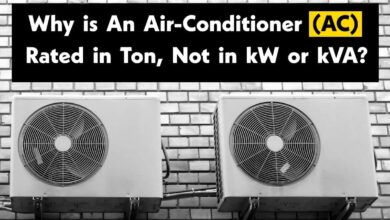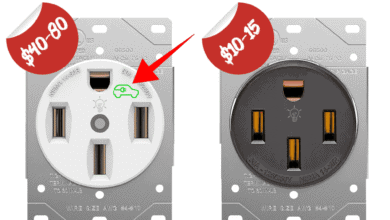Difference Between JFET and MOSFET
What is the Key Difference between JFET and MOSFET?
JFET and MOSFET are two different types of Field-Effect transistors (FET). They both use an electric field or voltage at the gate to control the output current flow or voltage. They both are unipolar transistors, unlike BJT which is bipolar and uses current at the base to control the output current. Apart from that JFET and MOSFET have various other differences.
Related Posts:
Before going into the differences between JFET and MOSFET, we are going to discuss their basics first.
JFET (Junction Field Effect Transistor)
JFET is an acronym for Junction Field Effect Transistor. It is a type of field-effect transistor or FET having three terminals named Drain, Gate and Source.


In P-channel JFET, the current flow is due to holes while in N-channel JFET, the current flow is due to the electrons.
In normal conditions, at 0 volts at the gate, the JFET conducts maximum current. By increasing the reverse voltage between the gate and source, the depletion region increase that pinches the channel to decrease the amount of flowing current. By increasing the reverse voltage above the threshold, a point comes where the depletion region completely blocks the channel and the JFET stops the flow of current between the Drain and Source. Such type of operation mode is also known as Depletion mode and JFET only works in this mode.
Related Posts:
- Difference Between Diode and SCR (Thyristor)
- Difference Between Diode and Transistor
- What is The Difference Between Transistor and Thyristor (SCR)?
MOSFET (Metal Oxide Semiconductor Field Effect Transistor)
MOSFET is an acronym for Metal Oxide Semiconductor Field Effect Transistor. MOSFET is also known as IGFET (insulated gate field effect transistor). It is a four-terminals device having Drain, Gate, Source and Body terminals. The body terminal is often shorted with the source terminal thus forming three terminals.



MOSFET has two main types i.e. Depletion mode and Enhancement mode MOSFET. In depletion mode, the channel is already made under no voltage condition. The MOSFET allows maximum current through its channel. By applying, reverse voltage to the gate the channel width is decreased to reduce the amount of current flow. The JFET also works and only works in depletion mode.
In enhancement mode, there is no channel under normal conditions i.e. the MOSFET does not conduct when there is no voltage at its gate. By applying voltage, a channel is introduced between its source and drain. The voltage is directly proportional to the width of the channel. Thus the voltage is used for controlling the current flow.
However, there is a disadvantage of the insulating metal oxide layer. It produces a capacitance between the gate and channel. This makes it unstable for any static charge. If a little amount of static charge builds upon it, it may break through and damage the MOSFET. Therefore, the MOSFET is fragile and easier to destroy as compared to JFET.
Related Posts:
Main Differences Between JFET & MSOFET
The following comparison table shows the main differences between JFET and MSOFET.
| JFET | MOSFET |
| JFET stands for “Junction Field Effect Transistor“. | MOSFET stands for “Metal Oxide Semiconductor Field Effect Transistor“. |
| It has 3 terminals having drain, gate and source. | It has 4 terminals having drains, gate, source and body. |
| It has only two types i.e. N-Channel JFET and P-Channel JFET. | It has 4 types i.e. N-Channel Depletion MOSFET, P-Channel Depletion MOSFET, N-Channel Enhancement MOSFET and P-Channel Enhancement MOSFET. |
| The gate is directly connected with the channel. | The gate is insulated from the channel using an insulating layer of silicon oxide. |
| JFET is normally ON transistor that conducts when there is no gate voltage. | E-MOSFET is normally OFF transistor that does not conduct when there is no gate voltage. |
| It has comparatively low input impedance than MOSFET approximately in the range of 109 Ohm. | It has very high input impedance in the range of 1014 ohm. |
| The leakage current in JFET is higher than MOSFET. | The leakage current is very small as compared to JFET. |
| JFET consume higher power than MOSFET. | MOSFET consumes less power. |
| It works in only depletion-mode. | MOSFETs are available in Depletion mode and Enhancement mode. |
| It has a comparatively lower switching speed. | It has a very high switching speed as compared to JFET. |
| JFET manufacturing is very simple. | MOSFET manufacturing is comparatively complex. |
| JFET is cheaper as compared to MOSFET. | MOSFET is expensive. |
| JFET has a comparatively larger gain than MOSFET. | MOSFET has a lower gain than JFET. |
| JFET can handle large voltages. | MOSFET cannot handle large voltages. |
| It is used in low noise, high-frequency application. | It is used in high noise, very high RF applications. |
Related Posts:
- Difference Between Microprocessor and Microcontroller
- Difference Between 8085 and 8086 Microprocessor – Comparison
Properties and Characteristics of MOSFET & JFET
The following different properties differentiate both JFET & MOSFET having different characteristics and applications.
Construction
- The JFET has a comparatively very simple construction.
- There is a channel and the gate is directly connected with the channel surrounding it.
- The MOSFET has a complex design.
- There is an insulating metal oxide layer between the gate and channel.
Terminals
- The JFET has three terminals including Drain, Gate and Source.
- The MOSFET has four terminals including Drain, Gate, Source and Body.
- However, the Body is often shorted with the source terminal.
Modes of Operation
- The JFET only works in Depletion Mode
- The MOSFET works in both Depletion Mode and Enhancement Mode.
Types
- JFET has two types based on their channel i.e. N-Channel JFET and P-Channel JFET.
- MOSFET has two main types based on their operation mode i.e. Depletion MOSFET and Enhancement MOSFET.
- The Depletion MOSFET is further classified into two types: N-Channel Depletion MOSFET & P-Channel Depletion MOSFET.
- The Enhancement MOSFET is also further classified into two types: N-Channel Enhancement MOSFET and P-Channel Enhancement MOSFET.
Related Posts:
- Difference Between CPU and GPU – Comparison
- Difference between Analog and Digital Circuit – Digital vs Analog
Insulated Gate
- In JFET, there is no insulation between the gate and the channel.
- In MOSFET, there is an insulating layer of metal oxide between the gate and channel.
Input Impedance
- The input impedance of JFET is higher than BJT because it operates in reverse bias.
- Its input impedance ranges in 109 Ohms.
- The MOSFET’s input impedance far more than JFET due to the presence of insulation between its gate and channel.
- Its input impedance ranges in 1014 Ohms.
Leakage Current
- Since the JFET has lower input impedance than MOSFET, it has a greater leakage current than MOSFET.
- MOSFET due to its huge input impedance has almost negligible leakage current.
Switching Speed
- JFET has a faster switching speed than BJTs.
- While MOSFET has far more switching speed than JFET.
Gain
- The JFET has a lower gain than a BJT.
- While the MOSFET has a lower gain than a JFET.
Voltage handling
- The JFET can handle high voltages and it is far more stable than MOSFET.
- Due to the presence of a metal oxide layer, there is a capacitance between the gate and channel which can get damaged due to any charge buildup.
- Therefore, MOSFETs are very sensitive and fragile in voltage handling.
Cost
- Due to JFET’s simple design and easier construction, they are cheaper than MOSFET.
- MOSFETs have a complex design, therefore, they are very expensive than FET.
Power Consumption
- JFET has a leakage current greater than MOSFET, therefore, JFET consumes more power.
- MOSFET has negligible leakage current which consumes less power.
Application
- JFET is used in low noise and high-frequency applications.
- MOSFETs are used in high noise and very high-frequency applications.
Similarities
- Both JFET and MOSFET are unipolar devices having only one type of charge carrier used for current flow.
- Both JFET and MOSFET are transistors having lower gain as compared to BJT (Bipolar Junction Transistor).
- Both JFET and MOSFET are voltage-controlled transistors.
- Both are used for amplification as well as switching.
- Both are used for amplifying weak voltage signal.
- Both types of transistors do not allow the gate current flow.
- Both JFET and MOSFET can have either P-Channel or N-Channel.
- Both JFET and MOSFET are compact having a small size.
- Both JFET is used in electronics such as in integrated and embedded circuits etc.
Related Posts:
- Difference between Electron Current and Conventional Current
- Difference Between RAM and ROM – Comparison
- Difference Between Synchronous and Asynchronous Transmission
- Difference between Inverter and UPS – Uninterruptible Power Supply
- Difference Between Online UPS and Offline UPS – Which One is Better?
- Diode Symbols – Electronic and Electrical Symbols
- Transistor, MOSFET and IGFET Symbols
- How to Check a Transistor by Multimeter (DMM+AVO) – NPN and PNP – 4 Ways
- How to Test a Diode using Digital and Analog Multimeter – 4 Ways.
- Bipolar Junction Transistor (BJT) | Construction, Working, Types & Applications
- Thyristor and Silicon Controlled Rectifier (SCR) – Thyristors Applications








